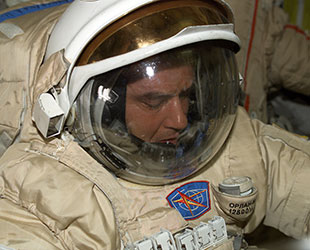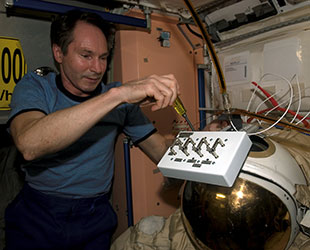February 3, 2006 – When it comes to Russian spacesuits, what goes up, most often does not come down... at least not in one piece.
Russian Orlan spacesuits, which cosmonauts, and more recently, astronauts, use to perform spacewalks outside space stations, are designed to be stored, serviced and used again without ever being returned to the ground. The logistics required for landing a bulky Orlan is not among the capacity or capability of Russian descent spacecraft.
So, it won't be unusual when later today the crew of the International Space Station discards a suit of theirs that has outlived its usefulness. How they will do so however is rare and what it will do afterwards is nothing but unique.
On earlier Soviet Salyut stations, the suits used were left aboard to burn up in the atmosphere as the outpost itself reentered. Later, on Mir (and the ISS), old Orlans typically were stowed in spent supply ships and left to meet the same fate. Occasionally though, their fiery end has been more creative.
At least twice before, Orlans have bypassed riding home in a Progress vehicle to be thrown forcibly overboard by cosmonauts wearing their replacements. The suits were still destined to deorbit, but their exits took on the classic sci-fi scene of a stranded spaceman falling while flailing.
Perhaps recognizing just such a potential, Mir residents Vasili Tsibliyev and Alexander Serebrov rigged their soon to be space junked spacesuit in October 1993 to appear as though it was saluting. The send-off was said to have been caught on film but the images have never (officially) been released to the public.
That won't be the case today however, when all available cameras will be pointed toward Valery Tokarev as he gives Orlan-M no. 14 a good shove and sends it soaring on its way from the ISS.
Double '0' Fourteen

Valery Korzun, Expedition 5 commander, attired in a Russian Orlan spacesuit. The same suit will become the first SuitSat. (NASA) |
Orlan-M 14 (or more specifically, 1280014 as printed on its front) arrived on the ISS on September 16, 2001 with the Russian docking compartment Pirs (the same airlock that Tokarev and his crewmate William McArthur will exit and enter through today).
Marked with blue stripes (as opposed to red) to facilitate identifying the wearer, no. 14 was first donned in space by Expedition 4 Commander Yuri Onufrienko for a pair of EVAs (extravehicular activities or spacewalks) in January 2002. Encased in the Orlan, Onufrienko (with crewmates Carl Walz and Daniel Bursch individually) extended a 50 foot cargo crane and installed two radio antennas and six thruster deflectors outside the station.
Next to wear the spacesuit was Expedition 5 commander Valery Korzun, who, with U.S. astronaut Peggy Whitson on August 16, 2002, and Sergei Treschev one week later, positioned debris shields, experiments and equipment (as well as two more ham radio antennas).
More than a year later, Expedition 8 commander Michael Foale became the last to wear Orlan-M no. 14 while on a spacewalk. He and crewmate Alexander Kaleri retrieved, relocated and deployed experiments before their time was cut short by a faulty cooling system inside Kaleri's Orlan.
In total, Orlan-M no. 14 protected three crewmembers for 20 hours and 44 minutes outside the ISS. When it leaves today, it will have been on the station for over four years.
A new (short) lease on life

Valery Tokarev puts the finishing touches on an old Russian Orlan spacesuit that will be released by his hand from the International Space Station during a spacewalk on Feb. 3, 2006. (NASA) |
Before no. 14 becomes just another shooting star in the sky, it will take on an unprecedented mission. Equipped with three batteries, a radio transmitter and sensors to measure internal temperature and power levels, the Orlan will become a satellite — a SuitSat — transmitting its condition to the ground. The telemetry will be preceded by a prerecorded greeting in five languages.
Though its mission will be short-lived — at most a week or two — SuitSat will remain in its own orbit for as much as six weeks before re-entering the atmosphere. SuitSat is sponsored by an international group of volunteers from amateur radio societies.
Also "aboard" the Orlan is a CD with images of over 300 items — art, signatures, logos and portraits — collected from schools and educational organizations around the world. Students are being encouraged to try to detect the signal beamed by SuitSat and listen for "special words" in its message. Those who do can apply to receive honorary certificates.
The transmission, which can be picked up by a receiver tuned to 145.990 MHz FM, begins with the words "This is SuitSat-1, RS0RS," and ends with a "Slow Scan" picture. The image is another secret for students to try to identify.
SuitSat's success may lead to more retired Orlans joining no. 14, making the transition from personal spacesuit to orbiting satellite.
